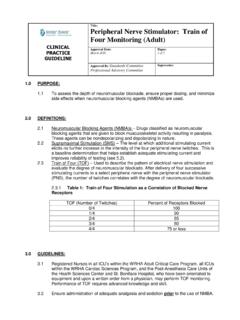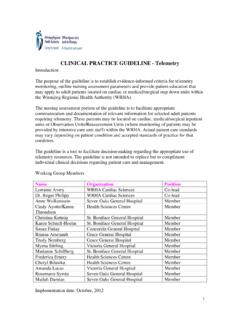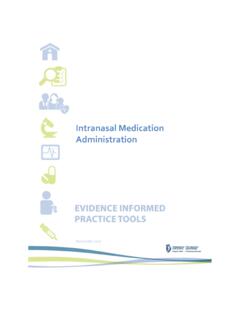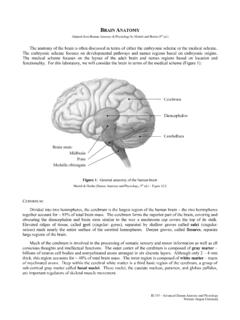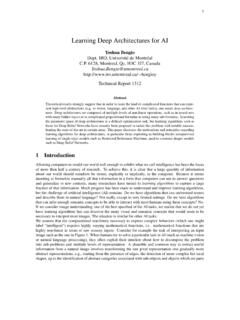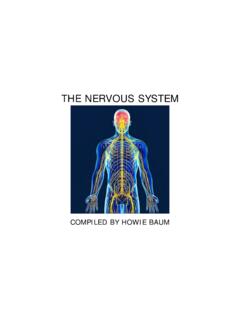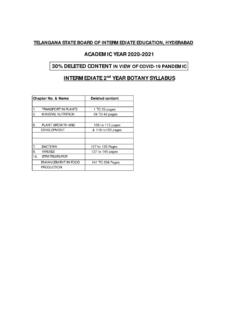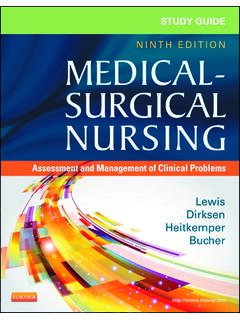Transcription of An Evidence Based Occupational Therapy Toolkit for ...
1 Pa ge 1 of 69 An Evidence Based Occupational Therapy Toolkit for Assessment and Treatment of the Upper Extremity Post Stroke Brenda Semenko, Leyda Thalman, Emily Ewert, Renee Delorme, Suzanne Hui, Heather Flett, Nicole Lavoie (Winnipeg Health Region Occupational Therapy Upper Extremity Working Group) April 2015 Updated February 2017 and August 2021 Pa ge 2 of 69 Table of Contents: Section Number Section Name Page Number Acknowledgements 4 Introduction 5 A Model for Upper Extremity Assessment and Treatment Post Stroke 6 Screening Guidelines Screening Questions 7 8 Determining Upper Extremity Level Guidelines 9 Assessment Guidelines Assessment Matrix Motor Function Coordination Strength Range of Motion Tone Pain Sensation Edema 10 11 12 12 12 13 13 13 14 14 Goal Setting Guidelines 15 Treatment Guidelines Treatment Matrix Task Specific Training Guidelines Arm Activity List A Arm Activity List B Homework A Homework B Homework C Treatment Contract Constraint Induced Movement Therapy Functional Dynamic Orthoses Functional Electrical
2 Stimulation Mental Imagery Mental Imagery Sample Script Joint Protection and Supports Positioning and Supporting the Arm in Lying and in Sitting Bed & Chair Positioning Following a Stroke Right Bed & Chair Positioning Following a Stroke Left Positioning and Supporting the Arm during Transfers and Mobility Sling Me? Positioning Devices Positioning and Supporting the Hand Splint Instructions Shoulder Girdle Taping Spasticity Management 16 17 20 21 22 23 24 25 26 27 28 29 30 31 32 32 33 34 35 36 37 38 40 41 42 Pa ge 3 of 69 Section Number Section Name Page Number Supplementary Training Programs Mirror Therapy Mirror Therapy Sample Script sensory Stimulation and Re-training sensory Re-training Practical Examples Safety Tips for Decreased Sensation Range of Motion and Strength Training Self-Range of Motion Exercises for the Arm Edema Management Virtual Reality 43 44 45 46 47 48 49 50 62 63 Reassessment Guidelines 64 References 65 Pa ge 4 of 69 Acknowledgements.
3 The Winnipeg Health Region Occupational Therapy Upper Extremity Working Group would like to acknowledge and thank the following individuals for their contributions to this document: Daniel Doerksen Denali Enns Laura Foth Glen Gray Sherie Gray Danielle Harling Shayna Hjartarson Michelle Horkoff Sue Lotocki Mona Maida Linda Merry Lambert Sharon Mohr Cristabel Nett Louise Nichol Teresa Ouellette Naomi Sawchuk Meghan Scarff Kristel Smith Marlene Stern Ted Stevenson Kaleigh Sullivan Laura Wisener Pa ge 5 of 69 Introduction: Stroke is a common neurological medical condition. Every year 62,000 Canadians experience a stroke or transient ischemic attack (Hebert et al., 2016) and 405,000 Canadians live with the effects of stroke, with that number projected to increase to between 654,000 and 726,000 by 2038 (Krueger et al.)
4 , 2015). Stroke impacts an individual s ability to participate in former activities and life roles. Occupational therapists provide assessment and treatment to increase independence in self-care, productivity, and leisure activities, and frequently work with clients recovering from stroke. The literature on stroke rehabilitation is continually evolving; therefore, Occupational therapists must be knowledgeable about Evidence - Based practice and apply it within their practice settings. The Canadian Stroke Best Practice Recommendations (rehabilitation modules) were updated in 2015, 2017 and again in 2019 and published in the International Journal of Stroke in 2020 (Teasell et al., 2020). The upper extremity sections of the Recommendations are of significant value to Occupational therapists who frequently work with clients to maximize upper extremity function post stroke.
5 Occupational therapists have noted variations in upper extremity rehabilitation practice between sites and programs in Winnipeg, Manitoba, and have identified the need for increased knowledge to improve the consistency of practice across the stroke rehabilitation continuum of care. A working group was created in an attempt to consistently implement the upper extremity sections of the Canadian Stroke Best Practice Recommendations into daily clinical practice. A group of Occupational therapists from the Winnipeg Health Region collaborated to create a practical Toolkit for Occupational therapists working in acute, rehabilitation, outpatient, and community settings. Although this Toolkit was developed specifically for Occupational therapists, it is hoped that it will also be of benefit to physiotherapists, rehabilitation assistants, and other healthcare professionals working on upper extremity recovery post stroke.
6 Several Occupational therapists and physiotherapists provided feedback throughout various stages of the Toolkit development. The Toolkit includes: a model for upper extremity management, a list of upper extremity assessment considerations and tools, and a list of specific upper extremity treatments, including practical resources. The Toolkit was initially informed by the 2013 Canadian Stroke Best Practice Recommendations, as well as expertise from Winnipeg Occupational therapists across practice settings. The Toolkit was updated after the release of the 2015 Canadian Stroke Best Practice Recommendations (Stroke Rehabilitation Module) and updated a second time after the release of the 2019 Canadian Stroke Best Practice Recommendations: Rehabilitation, Recovery, and Community Participation following Stroke.
7 The purpose of this Toolkit is to improve the consistency of implementing best practice management of the upper extremity following stroke. It provides information to assist Occupational therapists with clinical decision making as they assess, treat and educate clients recovering from stroke, with the ultimate goal of promoting client self-management. The affected upper extremity has been categorized into low, intermediate or high levels to guide Occupational therapists with selecting appropriate assessment tools and treatments. Occupational therapists still need to consider their client s physical status, cognition, perception, affect, and motivation, as well as their physical and social environments when implementing the resources in this Toolkit . The Evidence for upper extremity rehabilitation post stroke continues to emerge.
8 It is critical that Occupational therapists are knowledgeable about the most recent Evidence as well as the recommendations and resources available to promote optimal upper extremity function throughout the stroke rehabilitation continuum of care. Pa ge 6 of 69 A Model for Upper Extremity Assessment and Treatment Post Stroke A model was developed to illustrate a recommended process for management of the upper extremity (UE) post stroke. This process includes an approach to screening, assessment, and treatment with each step of the model further described in this Toolkit . intermediate Assess UE ( Based on level) Determine UE Goals Treat UE ( Based on level) Reassess UE Screen UE Function Determine UE Level Low High Pa ge 7 of 69 Screening Guidelines: The Canadian Stroke Best Practice Recommendations states: Initial screening and assessment should ideally be commenced within 48 h of admission by rehabilitation professionals in direct contact with the patient ( Evidence Level C) (Teasell et al.)
9 , 2020, p. 767). An initial screen of upper extremity function is crucial at all points of the rehabilitation continuum of care. The screen will determine further assessments required, assist with goal setting, and assist with the choice of specific upper extremity treatments to best promote recovery and prevent complications ( , pain, subluxation, edema, contracture). The following page is an example of some initial screening questions. Questions should be modified Based on the individual client s presentation. Pa ge 8 of 69 Screening Questions: Determine dominant upper extremity. Compare affected side to less affected side. Shoulder subluxation and position of scapula at rest: Feel for shoulder subluxation. Feel position of scapula on ribcage (both with and without active arm movement).
10 Motor Function: (Note which movement components are missing vs. weak as well as selectivity of movement) Shrug your shoulders toward the ceiling and down. (scapula elevation/depression) Squeeze your shoulder blades together. (scapula retraction) Pretend you are giving someone a hug. (scapula protraction) Raise your arm in front of you to the ceiling. (thumb up if possible) (shoulder flexion in neutral alignment) Raise your arm to the side. (palm up if possible) (shoulder abduction) Put your hand behind your back. (shoulder internal rotation) Put your hand behind your head. (shoulder external rotation; should also be screened in sitting with elbow flexed 90 degrees and forearm parallel to the ground; screen for AROM/PROM and strength) Touch your chin with your hand.



